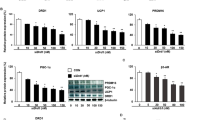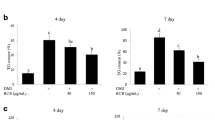Abstract
The primary goals of the present study were to investigate the inhibitory effects of bromocriptine (BC) on adipogenesis and lipogenesis in 3T3-L1 adipocyte cells as well as to elucidate its molecular mechanism of action. Adipogenic and lipogenic capacity of BC-treated cells was evaluated by oil red-O staining, triglyceride content assay, real-time RT-PCR and immunoblotting. To determine the mechanism responsible for the anti-obesity effect of BC, we applied two methods. Firstly, we knocked down dopamine D2 receptor (D2R) up to 50 % using siRNA. Secondly, we blocked the activity of α2-adrenergic receptor (α2-AR) by yohimbine treatment and monitored its effects on adipogenic and lipogenic events in 3T3-L1 cells. BC decreased the expression levels of adipogenic activators, including Pparα, Pparγ, and Cebpα, as well as major lipogenic target genes, including Me1, Acc1, 6Pgd, Fasn, and Prkaa1. Moreover, BC markedly reduced intracellular nitric oxide formation in a dose-dependent manner and expression of pro-inflammatory genes, Tnfα and Il6, which reflects attenuated pro-inflammatory responses. Further, upon treatment with BC, D2R-deficient cells displayed a significant decrease in lipogenic activity compared to control cells, whereas yohimbine-treated cells exhibited no reduction in lipogenic activity. BC can effectively attenuate adipogenesis and lipogenesis in 3T3-L1 cells by downregulating the expression of lipogenic genes and proteins. Our current experimental data collectively establish that the anti-obesity effects of BC are not D2R-dependent but result from the action of α2-AR in 3T3-L1 adipocytes.






Similar content being viewed by others
Abbreviations
- ACC:
-
Acyl CoA carboxylase
- AMPK (Prka):
-
AMP-activated protein kinase (encoded gene)
- AR:
-
Adrenergic receptor
- BC:
-
Bromocriptine
- C/ebp :
-
Gene encoding CCAAT/enhancer-binding protein
- DR:
-
Dopamine receptor
- FAS (Fasn):
-
Fatty acid synthase (encoded gene)
- KD:
-
Knockdown
- Lep:
-
Leptin
- Il :
-
Gene encoding interleukin
- Me:
-
Malic enzyme
- NO:
-
Nitric oxide
- Pgd :
-
Gene encoding phosphogluconate dehydrogenase
- PPAR:
-
Peroxisome proliferator-activated receptor
- siRNA:
-
Small interference RNA
- Tnf :
-
Gene encoding tumor necrosis factor
- YB:
-
yohimbine
References
Cincotta AH, Meier AH (1989) Reductions of body fat stores and total plasma cholesterol and triglyceride concentrations in several species by bromocriptine treatment. Life Sci 45(23):2247–2254
Cincotta AH, MacEachern TA, Meier AH (1993) Bromocriptine redirects metabolism and prevents seasonal onset of obese hyperinsulinemic state in Syrian hamsters. Am J Physiol 264(2 Pt 1):E285–E293
Cincotta AH, Tozzo E, Scislowski PW (1997) Bromocriptine/SKF38393 treatment ameliorates obesity and associated metabolic dysfunctions in obese (ob/ob) mice. Life Sci 61(10):951–956
Janssen GB, Beems RB, Elvers LH, Speijers GJ (2000) Subacute toxicity of alpha-ergocryptine in Sprague-Dawley rats. 2: metabolic and hormonal changes. Food Chem Toxicol 38(8):689–695
Barnett AH, Chapman C, Gailer K, Hayter CJ (1980) Effect of bromocriptine on maturity onset diabetes. Postgrad Med J 56(651):11–14
Cincotta AH, Meier AH, Cincotta M Jr (1999) Bromocriptine improves glycaemic control and serum lipid profile in obese Type 2 diabetic subjects: a new approach in the treatment of diabetes. Expert Opin Investig Drugs 8(10):1683–1707. doi:10.1517/13543784.8.10.1683
Yoshikawa T, Minamiyama Y, Naito Y, Kondo M (1994) Antioxidant properties of bromocriptine, a dopamine agonist. J Neurochem 62(3):1034–1038
Grant P (2011) Improving perioperative diabetes care. Clin Med 11(3):298
Kok P, Roelfsema F, Frolich M, van Pelt J, Stokkel MP, Meinders AE, Pijl H (2006) Activation of dopamine D2 receptors simultaneously ameliorates various metabolic features of obese women. Am J Physiol Endocrinol Metab 291(5):E1038–E1043. doi:10.1152/ajpendo.00567.2005
Davis LM, Pei Z, Trush MA, Cheskin LJ, Contoreggi C, McCullough K, Watkins PA, Moran TH (2006) Bromocriptine reduces steatosis in obese rodent models. J Hepatol 45(3):439–444. doi:10.1016/j.jhep.2006.03.019
Davis LM, Michaelides M, Cheskin LJ, Moran TH, Aja S, Watkins PA, Pei Z, Contoreggi C, McCullough K, Hope B, Wang GJ, Volkow ND, Thanos PK (2009) Bromocriptine administration reduces hyperphagia and adiposity and differentially affects dopamine D2 receptor and transporter binding in leptin-receptor-deficient Zucker rats and rats with diet-induced obesity. Neuroendocrinology 89(2):152–162. doi:10.1159/000170586
Pijl H, Ohashi S, Matsuda M, Miyazaki Y, Mahankali A, Kumar V, Pipek R, Iozzo P, Lancaster JL, Cincotta AH, DeFronzo RA (2000) Bromocriptine: a novel approach to the treatment of type 2 diabetes. Diabetes Care 23(8):1154–1161
Via MA, Chandra H, Araki T, Potenza MV, Skamagas M (2010) Bromocriptine approved as the first medication to target dopamine activity to improve glycemic control in patients with type 2 diabetes. Diabetes Metab Syndr Obes 3:43–48
Defronzo RA (2011) Bromocriptine: a sympatholytic, d2-dopamine agonist for the treatment of type 2 diabetes. Diabetes Care 34(4):789–794. doi:10.2337/dc11-0064
Borcherding DC, Hugo ER, Idelman G, De Silva A, Richtand NW, Loftus J, Ben-Jonathan N (2011) Dopamine receptors in human adipocytes: expression and functions. PLoS ONE 6(9):e25537. doi:10.1371/journal.pone.0025537
Pasqualini C, Weltzien FA, Vidal B, Baloche S, Rouget C, Gilles N, Servent D, Vernier P, Dufour S (2009) Two distinct dopamine D2 receptor genes in the European eel: molecular characterization, tissue-specific transcription, and regulation by sex steroids. Endocrinology 150(3):1377–1392. doi:10.1210/en.2008-0578
de Leeuw van Weenen JE, Parlevliet ET, Maechler P, Havekes LM, Romijn JA, Ouwens DM, Pijl H, Guigas B (2010) The dopamine receptor D2 agonist bromocriptine inhibits glucose-stimulated insulin secretion by direct activation of the alpha2-adrenergic receptors in beta cells. Biochem Pharmacol 79 (12):1827–1836. doi:10.1016/j.bcp.2010.01.029
Bradford MM (1976) A rapid and sensitive method for the quantitation of microgram quantities of protein utilizing the principle of protein-dye binding. Anal Biochem 72:248–254
Guevara I, Iwanejko J, Dembinska-Kiec A, Pankiewicz J, Wanat A, Anna P, Golabek I, Bartus S, Malczewska-Malec M, Szczudlik A (1998) Determination of nitrite/nitrate in human biological material by the simple Griess reaction. Clin Chim Acta 274(2):177–188
Shoelson SE, Herrero L, Naaz A (2007) Obesity, inflammation, and insulin resistance. Gastroenterology 132(6):2169–2180. doi:10.1053/j.gastro.2007.03.059
Wellen KE, Hotamisligil GS (2003) Obesity-induced inflammatory changes in adipose tissue. J Clin Invest 112(12):1785–1788. doi:10.1172/JCI20514
Cirino G, Distrutti E, Wallace JL (2006) Nitric oxide and inflammation. Inflamm Allergy Drug Targets 5(2):115–119
Scislowski PW, Tozzo E, Zhang Y, Phaneuf S, Prevelige R, Cincotta AH (1999) Biochemical mechanisms responsible for the attenuation of diabetic and obese conditions in ob/ob mice treated with dopaminergic agonists. Int J Obes Relat Metab Disord 23(4):425–431
Carson MJ, Thomas EA, Danielson PE, Sutcliffe JG (1996) The 5HT5A serotonin receptor is expressed predominantly by astrocytes in which it inhibits cAMP accumulation: a mechanism for neuronal suppression of reactive astrocytes. Glia 17(4):317–326. doi:10.1002/(SICI)1098-1136(199608)17:4<317:AID-GLIA6>3.0.CO;2-W
Agurs-Collins T, Fuemmeler BF (2011) Dopamine polymorphisms and depressive symptoms predict foods intake. Results from a nationally representative sample. Appetite 57(2):339–348. doi:10.1016/j.appet.2011.05.325
Gregoire FM, Smas CM, Sul HS (1998) Understanding adipocyte differentiation. Physiol Rev 78(3):783–809
Fajas L, Auboeuf D, Raspe E, Schoonjans K, Lefebvre AM, Saladin R, Najib J, Laville M, Fruchart JC, Deeb S, Vidal-Puig A, Flier J, Briggs MR, Staels B, Vidal H, Auwerx J (1997) The organization, promoter analysis, and expression of the human PPARgamma gene. J Biol Chem 272(30):18779–18789
Daval M, Foufelle F, Ferre P (2006) Functions of AMP-activated protein kinase in adipose tissue. J Physiol 574(Pt 1):55–62. doi:10.1113/jphysiol.2006.111484
Kola B, Grossman AB, Korbonits M (2008) The role of AMP-activated protein kinase in obesity. Front Horm Res 36:198–211. doi:10.1159/0000115366
Hotamisligil GS, Spiegelman BM (1994) Tumor necrosis factor alpha: a key component of the obesity-diabetes link. Diabetes 43(11):1271–1278
Lee YH, Pratley RE (2005) The evolving role of inflammation in obesity and the metabolic syndrome. Curr Diabetes Rep 5(1):70–75
Uysal KT, Wiesbrock SM, Marino MW, Hotamisligil GS (1997) Protection from obesity-induced insulin resistance in mice lacking TNF-alpha function. Nature 389(6651):610–614. doi:10.1038/39335
Di Gregorio GB, Hensley L, Lu T, Ranganathan G, Kern PA (2004) Lipid and carbohydrate metabolism in mice with a targeted mutation in the IL-6 gene: absence of development of age-related obesity. Am J Physiol Endocrinol Metab 287(1):E182–E187. doi:10.1152/ajpendo.00189.2003
Rocha VZ, Folco EJ (2011) Inflammatory concepts of obesity. Int J Inflamm 2011:529061. doi:10.4061/2011/529061
Duncan BB, Schmidt MI, Pankow JS, Ballantyne CM, Couper D, Vigo A, Hoogeveen R, Folsom AR, Heiss G (2003) Low-grade systemic inflammation and the development of type 2 diabetes: the atherosclerosis risk in communities study. Diabetes 52(7):1799–1805
Schmidt MI, Duncan BB, Sharrett AR, Lindberg G, Savage PJ, Offenbacher S, Azambuja MI, Tracy RP, Heiss G (1999) Markers of inflammation and prediction of diabetes mellitus in adults (Atherosclerosis Risk in Communities study): a cohort study. Lancet 353(9165):1649–1652
Liang Y, Lubkin M, Sheng H, Scislowski PW, Cincotta AH (1998) Dopamine agonist treatment ameliorates hyperglycemia, hyperlipidemia, and the elevated basal insulin release from islets of ob/ob mice. Biochim Biophys Acta 1405(1–3):1–13
Luo S, Meier AH, Cincotta AH (1998) Bromocriptine reduces obesity, glucose intolerance and extracellular monoamine metabolite levels in the ventromedial hypothalamus of Syrian hamsters. Neuroendocrinology 68(1):1–10
Goldstein M, Lew JY, Sauter A, Lieberman A (1980) The affinities of ergot compounds for dopamine agonist and dopamine antagonist receptor sites. Adv Biochem Psychopharmacol 23:75–82
Acknowledgments
This work was supported by a Daegu University Research Grant 2012.
Author information
Authors and Affiliations
Corresponding author
Rights and permissions
About this article
Cite this article
Mukherjee, R., Yun, J.W. Bromocriptine inhibits adipogenesis and lipogenesis by agonistic action on α2-adrenergic receptor in 3T3-L1 adipocyte cells. Mol Biol Rep 40, 3783–3792 (2013). https://doi.org/10.1007/s11033-012-2455-5
Received:
Accepted:
Published:
Issue Date:
DOI: https://doi.org/10.1007/s11033-012-2455-5




